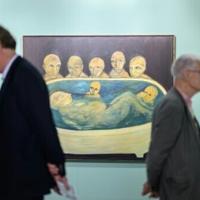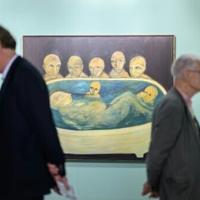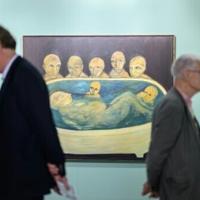Art Market
Rawaa Talass
Dec 31, 2024 2:00PM
Portrait of Nadine Kanso. Courtesy of Nadine Kanso.
On a sunny day in Dubai’s popular beachside neighborhood of Jumeirah, Artsy is here to meet Nadine Kanso. A native of Lebanon, Kanso has made a name for herself in Dubai thanks to her high-end jewelry company, Bil Arabi (meaning “In Arabic”), which celebrates the Arabic language, scripture, and identity.
Much like her own vision of crafting wearable statement pieces that render beloved Arabic words, Kanso’s art collection—be it at home or in her trendy office in the bustling Dubai Design District—is a thoughtful reflection of Arab creativity that spans across generations.
Kanso has lived with her family in a two-story villa for more than two decades, filling it with stacks of coffee table books, knickknacks acquired from travels, and, of course, a large variety of art. Her collection spans an eclectic range from contemporary to modern, Arabic to Western, and it explores themes both vibrant and solemn. A striking visual aspect of Kanso’s living and dining rooms is her bold and groovy choice of wall color—dark purple and green. On these walls hang maximalist clusters of artworks, which include paintings, photographs, and prints. Kanso, who is also a photographer, doesn’t go by rules when hanging her artworks, but rather by intuition, where not everything has to match.
Installation view, from left to right, of works by Françoise Nielly, Mohamed Ahmed Ibrahim, Mohamed El Rawas, and Nasir Nasrallah. Courtesy of Nadine Kanso.
Driss Ouadahi, installation view in Nadine Kanso’s office. Courtesy of Nadine Kanso.
Advertisement
“I think it’s a matter of taste and how I see things. It’s an organized chaos.…If something is beautiful, why not display and enjoy it?” she said of her buzzing layout of objects. “There are certain things that you can’t really explain: why you put stuff on the table like this, or why you decorate your house like that, or why you buy this kind of art. Visually, it needs to make sense to me and I need to relate to it and love it. It needs to talk to me.”
Kanso owns approximately 100 artworks but, notably, doesn’t consider herself an art collector. She has a particular soft spot for Arab artists, whether hailing from Lebanon, the United Arab Emirates, or Egypt. “I always believed that if we do not support our own artists, and make them get to higher places, then who would?” she told Artsy, donned in a casual chic pairing of jeans and a Gucci t-shirt. “Everyone else does that. Why not us? The least we can do is support this industry. This is how you make artists stronger.”
Kanso started buying artworks more than two decades ago, initially by regional artists such as Samir Sayegh and Mohammed El Rawas, notably delving into figurative art. In Kanso’s living room are French painter Françoise Nielly’s Untitled, Emirati artist Nasir Nasrallah’s Untitled, and Lebanese artist Mohammad El Rawas’s One of a Kind. There is also an intriguing portrait, Jamal El Din Al Afghani, by the pioneering Egyptian Armenian artist Chant Avedissian, who produced a stenciled image of Jamal El Din Afghani, a 19th-century Islamic reformist. Elsewhere hangs a lively painting of a Ferris wheel, Untitled, by the first-generation Emirati artist Mohammed Ahmed Ibrahim, who represented the U.A.E. at the Venice Biennale in 2022. The work was a gift for Kanso’s 50th birthday.
Installation view, clockwise from top left, of an archival print of Egyptian singer Umm Kulthum and works by Nadine Kanso. Courtesy of Nadine Kanso.
Another master in the group is the veteran artist Hussein Madi, dubbed the “Lebanese Picasso,” who died earlier this year. Hung in Kanso’s home is the artist’s work Lying Lady with the Pillow (1999). “I had met him years back and I have a copy of his book that he signed for me at the time,” Kanso said. “He was a special character, who was very outspoken.” A duo of eye-catching Arabic calligraphic images by the Lebanese artist Samir Sayegh, who was born in 1945, are also present. Kanso is a discerning fan of calligraphy, she noted.
“Calligraphy is my passion in life, but I’m very particular about it,” she explained. “It needs to be strong like this. I don’t like it to be classic calligraphy that you do in swirls. I mean, it’s beautiful and hard to do, so I appreciate it. Sayegh’s work is more thought-out, with an element of typography, not only calligraphy.”
As for the dining area, decorated with vintage radios and elegant candlestick holders, a standout in the room is a large portrait Malika (2022) by Spanish artist Angeles Agrela, who is known for portraying women in flashy colors and flamboyant hairstyles. “At the time, I didn’t know much about the artist, but I fell in love with the work,” she said.
Angeles Agrela, installation view of Malika, 2022. Courtesy of Nadine Kanso.
Installation view, from left to right, of works by Mohamed Ahmed Ibrahim, Huguette Caland, Mohamed El Rawas, and May Salem. Courtesy of Nadine Kanso.
Some of Kanso’s artworks also have a political edge. Among them is a poignant black-and-white photography piece by the Iranian artist Reza Aramesh, one of the first artists she bought art from. Entitled Action 65 (2009), the work juxtaposes two contradictory images: Egyptian prisoners captured by Israeli troops in 1967 huddled together against an opulent setting. “It’s about all that contrast of our lives,” she remarked. Palestinian artists, such as Rula Halawani, Samia Halaby, Larissa Sansour, and Hazem Harb, are also brought up by Kanso while touring her home. “Palestine has been a big part of our lives as Arabs,” she said.
As a longtime Dubai resident, Kanso has befriended gallerists and artists over the years. “I usually like to get to know the artist, not because I’m buying their art, but I like how they think and the stories behind their art,” she said. Some of her favorite galleries in the city are Ayyam Gallery, The Third Line, Lawrie Shabibi, and Gallery Isabelle.
Visiting Art Dubai, the U.A.E.’s premier annual art fair, is a must, too. In fact, at this year’s edition of Art Dubai, Kanso loaned one of her artworks—a red pillow-like sculptural piece, Expand (2018), by Emirati artist Shaikha Al Mazrou—to an on-site exhibition at the fair, organized by The Dubai Collection. “I was invited to talk on a panel with much bigger collectors, and I was the only woman,” she recalled. “I did not realize this until I sat down in my chair. But still, having my piece in that collection was a proud moment, actually.”
Indeed, as Kanso continues to discover new artists and artworks, the aim of her collection remains the same as it was two decades ago. “It is about being able to access beauty on a daily basis in the environment you are in,” she said. “You surround yourself with works that resonate with you, and tell you a story that means something to you, evoking feelings of happiness, memory, and nostalgia at times.”
Rawaa Talass
This post was originally published on this site be sure to check out more of their content



